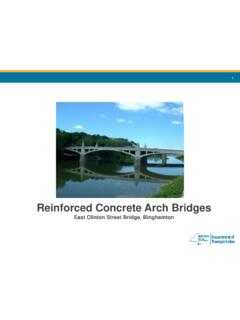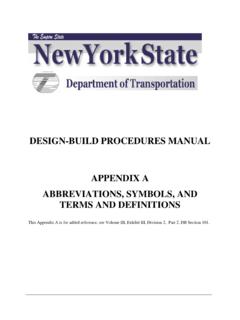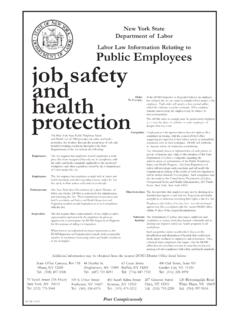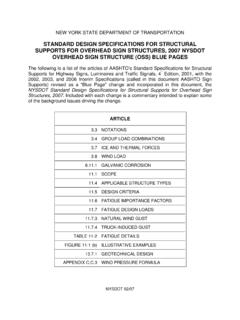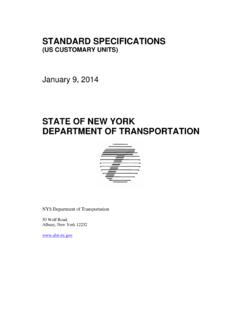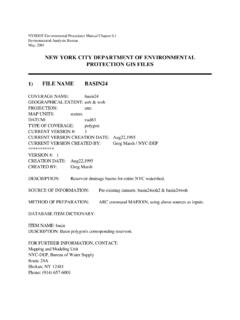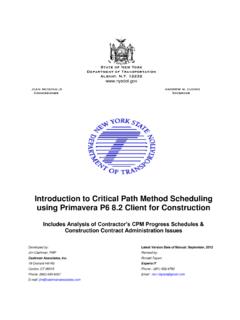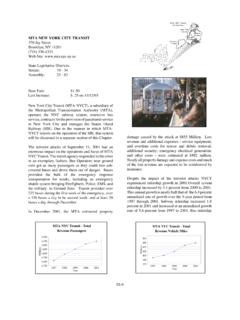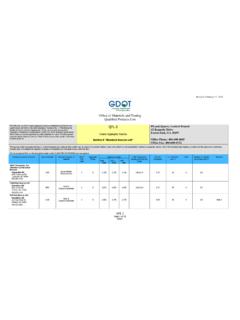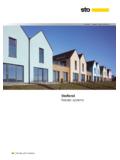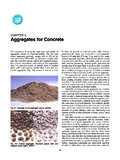Transcription of CHAPTER 3 - TYPICAL SECTIONS (Limited Revisions) Revision 44
1 HIGHWAY DESIGN MANUALCHAPTER 3 - TYPICAL SECTIONS (Limited Revisions) Revision 44 July 9, 20047/9/04 CHANGES TO CHAPTER 3 PagesChange3-26 Corrected typographical error in Section In the second paragraph, firstline, replaced lateral with horizontal . CHAPTER 3 TYPICAL SECTIONSC ontentsPage Terminology and of ELEMENTS OF THE TYPICAL Slope and Superelevation of Zone (Fill) of Way EXISTING and Additions and A - CONVENTIONAL ASPHALT OF FIGURES3-1 TYPICAL Elements of Limited Access Highways3-2 TYPICAL Elements for Urban Streets and Other Highways3-3 Placement of Select Granular Subgrade3-4 Conventional Edge of Traveled Way Details3-5 Recommended Rollover Combinations3-6 TYPICAL Shoulder Details for ESAL-based Asphalt Pavement Design3-7 TYPICAL Shoulder Details for ESAL-based Concrete Pavement Design3-8 TYPICAL Shoulder Rumble Strip Details3-9 TYPICAL Wide Medians3-10 TYPICAL Narrow Medians3-11 TYPICAL Curb and Edge Drain Placement3-12 Template Method for Driveway Profile Design3-13 Ninetieth Percentile Seasonal Snowfall Contours3-14 Normal Positions of Guide Rail Relative to Shoulder
2 Break3-15 High-Speed Traversable Ditch Section3-16 Traversable Ditch at Lateral Embankment3-17 Rock Slope Setback Options3-18 Detail of Asphalt Overlay Splice (Pavement Termination Detail)3-19 Rubblizing and Widening Details3-20 Detail of Underdrain Retrofitting3-21 Curb Addition Details (Stone or Precast)3-22 Edge of Shoulder Detail - Unditched Section3-23 Sample TYPICAL Section - Divided Highway3-24 Sample TYPICAL Section - Collector RoadLIST OF TABLES3-1 General Terminology (Limited Access and Other Highways)3-2 General Terminology (Urban Streets and Other Highways)3-3 Conventional Pavement Thickness Guide3-4 Functional Classification Code Descriptions (Highway Sufficiency Rating)3-5 Performance Graded Binder Selection3-6 Pavement Selection for Principal Arterials3-7 Pavement Selection for General Highways3-8 Limits on Permissible Lift Thicknesses3-9 Maximum Desirable Side Slopes3-10 Pavement Selection for General Highways - Conventional Asphalt3-11 Pavement Selection for High Volume Highways - Conventional Asphalt3-12 Limits on Permissible Lift Thicknesses - Conventional Asphalt11/20/983-111/20/98 3 TYPICAL SECTIONS describe the physical shape and relationship of the various highway elements thatare present at or proposed for a normal or TYPICAL interval along a highway.
3 This CHAPTER defines anddescribes the elements and presents guidance on details of their design. It also discusses how theindividual elements may be brought together to form TYPICAL SECTIONS for the different classificationsof CHAPTER begins by defining, in Section , the elements that make up TYPICAL SECTIONS andfollows, in , with a description of the two highway classification systems used in this presents discussions of the individual elements as they relate to new focuses on some of these elements as they relate to resurfacing, restoration andrehabilitation work on existing facilities. Section provides guidance on drawing layout,conventions, notes and general presentation of TYPICAL SECTIONS for construction contracts.
4 It alsoincludes example drawings. Section provides references for the many documents that providesupplementary information relevant to the preparation of TYPICAL Terminology and DefinitionsTables 3-1 and 3-2 present definitions of elements that may be included in the TYPICAL SECTIONS ofnew or reconstructed projects. Different arrangements of elements will be used depending on thefunctional classification of the highway. Figure 3-1 illustrates a TYPICAL arrangement for a limitedaccess highway. Figure 3-2 illustrates an arrangement of elements for urban streets. (Two tablesand two figures are provided for ease of illustration rather than to indicate exclusive use of theelements in one section or another.) The older a highway is, the more likely it is to differ from thesections of HighwaysTwo classification systems are used in this CHAPTER .
5 One, the Federal Aid System functionalclassification of highways, is used in the definition of the various critical design elements. Chapter2 provides the guidance on critical design elements for new and reconstructed highways, includingResurfacing, Restoration and Rehabilitation (3R) projects on Interstates and Freeways. Chapter7 of this manual provides additional requirements, standards and guidance for both freeway 3R andnon-freeway 3R projects. The second classification system is only used herein for hot mix asphaltpavement selection and thickness guidance (Section ) and is the system used in the HighwaySufficiency Rating SECTIONSSEE Table 3-1 General Terminology (Limited Access and Other Highways)1 Clear Area-The total roadside border area, starting at the edge oftraveled way and extending to the first hazardous (Back) Slope-A slope formed by Control Edge-The edge of traveled way nearest to a ditch.
6 Servesas the vertical control for Depth-Vertical distance from the ditch control edge to the invert ofditch in cut Ditch (Side) (Fore) Slope-The area between the shoulder break andthe ditch Ditch Back Slope-A desirable 3 m wide, 1:4 slope between the ditchinvert and the cut slope, used to enhance traversability. 6 Ditch Width-The width of the ditch invert or Drain-An underdrain located beneath the edge of pavement. SeeSections , , and and CHAPTER 9, section road-carrying raised structure typically composed of soiland rock materials placed and compacted under controlled conditionsbetween embankment foundation and subgrade Foundation-Surface upon which embankment isconstructed after all preparatory work is (Fill) Slope-A slope formed by an Ground-Location of ground or embankment surface at present.
7 (Compare with Original Ground)12 Guide Rail-Redirecting barrier installed adjacent to shoulder if adequateclear zone not available. May also be used for access control. (SeeChapter 10.)13 Highway-Whole strip of land bounded by ROW of road separating opposite direction Barrier-Barrier system used in median and designed to beimpacted on either side. (See CHAPTER 10.)16 Mowing Strip-Optional asphalt strip that may be provided under guiderail or behind a curb to inhibit plant Ground-Ground surface prior to any highway of Way or ROW-General term denoting land, property, or interest therein, usually in a strip, acquired for or devoted to a of Way Fence-Fence designed to discourage trespassing ontolimited access highways and to distinguish Department Right-of Way.
8 Generally runs as close as possible to the ROW line while maintaining astraight alignment. (See Section )20 Right of Way Line-Line denoting ROW lateral portion of the highway prepared to provide foundationsupport for the shoulders and pavement structure. The pavementstructure begins at the bottom of the subbase Section-Portion of highway included between top of slope in cutand bottom of slope in of highway included between outside edges of pavedshoulders (see for different definition in Vehicle and Traffic Law). Divided highways have two or more - Portion of the roadway contiguous with the traveled wayprimarily for accommodation of stopped vehicles for emergency use. (Also, preferred location for bicycle traffic using roadway.)
9 Provideslateral support for traveled way courses. Unless stated otherwise, theterm shoulder is generally taken to mean the paved Paved (Stabilized) Width-Portion of the graded width contiguouswith the traveled way and paved or stabilized to provide a better all-weather support than offered by the untreated subbase course. B. Graded Width - The area between the edge of traveled way and theshoulder Break-Point of intersection of the shoulder slope plane andthe embankment or ditch slope Joint-In Portland cement concrete pavements, the jointbetween the shoulder slab and the traveled way Course-Compacted layers of well-graded sand and gravelplaced as a foundation for pavement layers above it. 28 Subgrade Surface-The surface of the subgrade.
10 (Subgrade-roadbedsection upon which the subbase course is placed.)29 Traveled Way-Portion of roadway for movement of vehicles, exclusive ofshoulders. (Through Traveled Way-Portion of the roadway formovement of vehicles, exclusive of shoulders and auxiliary lanes.)3-4 TYPICAL SECTIONSSEE Table 3-2 General Terminology (Urban Streets and Other Highways)30 Asphalt (Hot Mix*),HMA-A pavement material consisting ofan aggregate and bituminous Top Course-Asphalt layer placed as riding surface. Generally, finest gradation except for shim Binder Course-Asphalt layer placed below top course. Gradation is intermediate between base and Base Course-Large aggregate asphalt layer placed asstructural base for overlying asphalt Permeable Base-Asphalt layer with limited fineaggregate, typically placed at bottom of asphalt sectionwhere needed to provide drainage and support.
